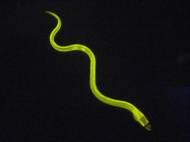Fluorescent protein from Unagi eel could revolutionize key clinical assay
 Being high in protein, vitamin A, and calcium, unagi found its way to become culinary delicacy in Japan. This sea-going Japanese freshwater eel seen a worldwide decrease in population, and its research could contribute to its conservation as well as lead to unexpected ways to help save human lives by increasing sensitivity, accuracy and speed of a common marker in blood tests.
Being high in protein, vitamin A, and calcium, unagi found its way to become culinary delicacy in Japan. This sea-going Japanese freshwater eel seen a worldwide decrease in population, and its research could contribute to its conservation as well as lead to unexpected ways to help save human lives by increasing sensitivity, accuracy and speed of a common marker in blood tests.
Japanese freshwater eels have a long-distance migration life cycle, growing in inland rivers and swimming far into the sea to spawn. RIKEN Brain Science Institute researchers found that unagi contains fluorescent protein – the first example found in vertebrates.
Drs. Atsushi Miyawaki, Akiko Kumagai and their team cloned a gene from Unagi that allows eels to glow in the dark. They named this unusual fluorescent protein UnaG (Unagi Green protein). But what makes UnaG truly unique in nature is that it needs a natural chemical to activate its powerful green light emission.
Surprisingly, the compound needed to activate the green light emission is bilirubin. Bilirubin is the breakdown product of blood hemoglobin and is toxic if present in excess in the body like in the characteristic yellow skin and eye color conditions seen in newborn babies, jaundice and kernicterus. It is also a common marker in blood tests where bilirubin is used by doctors to assess liver function and for the assessment of health, including hemolysis, the loss of red blood cells in anemia.
By analyzing the structure of UnaG, the team discovered a novel mechanism of fluorescence enabling bilirubin to bind to UnaG and activate its light emission. With this property, they developed a new assay for bilirubin with high sensitivity, accuracy and speed that may become the global clinical standard, and can be used in developing countries where child liver health is a major issue.
RIKEN Brain Science Institute researchers identified UnaG and bilirubin in the muscle cells of Japanese, American, and European eels where they may aid in endurance swimming during migration. The unexpected discovery of UnaG may initiate legislation to conserve endangered eel species.
“We believe that UnaG provides an unexpected foothold into several important but currently obscure areas of human health including bilirubin metabolism and muscle physiology during endurance exercise”, said Miyawaki. “Before the discovery of UnaG, I couldn’t imagine that basic science could have such a direct impact on human health. From a simple eel, we found a new path to the clinic.”
For more information, read the article published in the journal Cell: “A Bilirubin-Inducible Fluorescent Protein from Eel Muscle”.









Leave your response!